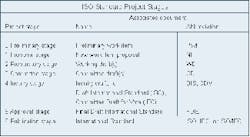A participant in the ISO's efforts answers frequently asked questions about the in-progress 600-MHz standard.
Last month, we brought you a question-and-answer session with Masood Shariff, a prominent member of the Telecommunications Industry Association's (TIA-Arlington, VA) TR-42 Engineering Committee. Shariff updated us on what's going on with Category 6 standards efforts.
This month, we turn our attention to Category 7/Class F. You may recall that last month, Shariff said the TIA has no immediate plans to pursue a Category 7 standard. But the International Organization for Standardization/International Electrotechnical Commission (ISO/IEC-Geneva, Switzerland) is steadfastly working toward a Category 7/Class F standard, as it has been for more than two years.
John Siemon, vice president of engineering at the Siemon Co. (Watertown, CT), brings us up to date on the efforts of this international standards body. The Siemon Co. developed Tera, a shielded twisted-pair (STP) connector interface that the ISO has recognized as a possible standard-referenced interface for Category 7/Class F.
CI&M: Let's start with some terminology. Is it true that the ISO has selected "primary" and "secondary" connector-interface designs for the Category 7/Class F standard, with your Tera connector chosen as the "secondary" interface and a design by Alcatel (Paris) designated as "primary?"
Siemon: I have been using the word "primary" in association with the Alcatel proposal, but another appropriate term would be "selected interface." Terms used by Working Group 3 (WG3), in correspondence and meeting minutes, to describe the other interface, are "backup" and "fallback."CI&M: Has the ISO set up a timetable by which the primary connector must be complete and operational? And can you comment on the progress so far?
Siemon: I am a member of the ISO/IEC Joint Technical Committee 1, Subcommittee 25, Working Group 3 (JTC1/SC25/WG3), which is responsible for specifying minimum requirements for cabling systems. Another subcommittee, IEC SC48B, develops standards that provide dimensional requirements to ensure intermateability, as well as minimum performance characteristics. After the meeting held in June 1999 in Berlin, SC25/WG3 sent a liaison letter to IEC 48B requesting the development of two new interface standards "in parallel."Regardless of which connector is referenced by SC25/WG3 in the second edition of ISO/IEC 11801 for Category 7/Class F, IEC SC48B will create two separate component standards. The reserved standard designation for the RJ-style is IEC 60603-7-7, while the reserved standard for the "fallback" is IEC 61076-3-104.
The plan is to reference one of these standards in the second edition of ISO/IEC 11801 for telecommunications outlet (TO) connections to Class F cabling. Requirements at other locations, such as distributors (known as crossconnects in the United States) and consolidation points, are performance-based to allow freedom of choice. With this letter, the difficult task of standardizing two Category 7 interfaces has effectively been handed off to IEC 48B. The best-defined milestone is the expressed desire that the IEC interface project be at the "final draft international standard (FDIS)" stage by December. The FDIS stage comes after the inquiry stage of standard development, meaning that the technical content is mature. As long as the FDIS receives the required number of affirmative country votes-a two-thirds majority-the document is published with editorial changes only. Any requests for technical changes are deferred to the next edition.
The liaison letter indicates that both connector designs will be validated to the requested IEC standard in terms of performance, including backward-compatibility of the RJ-style with other categories. Unfortunately, it does not provide specifics on when or how the validation will be carried out, or by whom. Therefore, the question of how WG3 will approach the ultimate decision, which relies on performance validation, is still subject to speculation.
While I feel that the only way of demonstrating standards compliance is with products that can be purchased through normal sales channels and independently verified, others may feel that testing of prototypes or preproduction units is sufficient. Since IEC 48B specializes in the creation of new standards rather than validation of products to the standards it creates, it will be interesting to see how the Working Group will approach this decision.
CI&M: Where does your Tera connector, as a fallback interface, fit into the scenario?
Siemon: While the question of whether the fallback interface will be called out for Class F TO connections remains unanswered, the interface is on track to become an IEC standard, which can be referenced by other standards in the future.Because there is no upper limit on performance, IEC 61076-3-104 can establish requirements that are representative of the full capabilities of the Tera's design. Doing so will go beyond the minimum Category 6 requirements and enable future regional or international telecommunications standards to adopt this interface when higher performance, modularity, or both, are required. For example, during the June meeting of SC25/WG3 in Tromso, Norway, a Danish proposal called for beginning work on another balanced cabling class with specific capabilities to support multimedia applications for residential and small office/home office installations, such as high-speed data as well as broadband analog.
While it is clearly preferable to complete the work on Categories 6 and 7 before starting new projects along these lines, there will likely be continued pressure to achieve a truly "generic" infrastructure based on the premise that higher performance will encompass more applications. If and when these proposals are accepted, the Tera interface, which already supports the proposed "next-generation" numbers up to 1.2 GHz, will be the logical choice.
It is just a matter of time before telecommunications applications force advances in structured cabling to go beyond traditional RJ-style connections. Naturally, this change will not take place overnight, but the availability of a market-proven IEC standard interface can only help to facilitate continued advancement of balanced cabling beyond the limitations of older technologies. With one high-speed copper interface and one fiber outlet to each desk, the range of supported applications and ability to accommodate future technologies will satisfy any network user's requirements.
CI&M: Regarding the Category 7/Class F standard, what technical issues, in addition to the connector interface, must be resolved? Does the ISO have a prioritized list of such technical issues?
Siemon: Items still under study are tagged in the drafts as "ffs" (for further study). While it is possible to publish a standard with items marked "ffs," this practice is discouraged because such specifications are considered to be preliminary and need not be met for conformance to the standard. There are still many items marked as "ffs" in the latest draft. These "half-frozen" specifications indicate that a significant amount of work must be completed before the document is ready for publication.Some highlights of the pending technical issues for Category 7/Class F include:
- Backward-compatibility for the RJ-style interface;
- Ability to meet the original design objective of positive power-sum attenuation-to-crosstalk ratio performance up to 600 MHz for Class F;
- Stabilized return-loss requirements for connectors, cables, links, and channels. Resolve conflicts between ISO/IEC, IEC, and CENELEC-the standards-making body for Europe. This item is related to link and channel model development that includes the effects of insertion-loss deviation;
- Field-testing to at least 600 MHz;
- A functional test methodology to verify shielding effectiveness of screened and shielded components, links, and channels; and
- Test methodologies and requirements for cable assemblies.
CI&M: Please explain the ISO/IEC's scheduling and balloting process.
Siemon: International standardization typically takes place as a six- or seven-stage process.Regarding scheduling, the time allotment for each stage generally depends on the project scope. The committee is responsible for establishing and managing target dates for the completion of each stage. As is the case with TIA projects, multiple ballots may be required during the Committee stage and Inquiry stage.
The second edition of ISO/IEC 11801 has just passed the Committee stage and will issue as a Draft International Standard this fall. Both the IEC 60603-7-7 and 61076-3-104 have completed the Committee stage and will be entering the Committee Draft for Vote stage next. The target date for both to become FDIS (which is actually the approval stage) is still the end of December.
CI&M: Please explain the Class/Category nomenclature of the ISO/IEC standards. Does "Class" refer to applications supported, while "Category" refers to cabling-system performance?
Siemon: Outside of the United States and Canada, cabling link and channel performance is designed by "classes" rather than "categories," which are only used in association with component-level requirements for cable and connectors. In the first edition of ISO/IEC 11801, the term "application class" is used interchangeably with cabling class. The approach was to research all available and pending standardized applications over balanced cabling, and establish minimum cabling link requirements that correspond generally to different tiers of applications.This application-down approach made it difficult to reconcile with the already-established TIA values, which were derived from a component-up model. For the next edition of 11801, it is recognized that there are not yet any established applications that require Class E or Class F cabling performance. As such, the link and channel requirements for these classes are based more on a component-up model (i.e., 90 meters of solid cable, plus 10 meters of stranded cable, plus four connectors) than on specific applications. Naturally, this supply-oriented approach requires some balance with input from the demand side of the equation. This balance is achieved through an active liaison relationship with applications developers (especially the IEEE 802 committees), whose influence on channel requirements remains extremely strong.
CI&M: So the ISO is not working on any "Class E" or "Class F" applications?
Siemon: In light of the burgeoning workload of this committee, it is a relief to answer that the efforts of SC25/WG3 are restricted to telecommunications infrastructure. That is, they do not also develop applications to be used on the cabling they specify. However, there are other ISO/IEC committees that actively develop and standardize new telecommunications applications.Notwithstanding the fact that the Category 6/Class E requirements are still pending approval, the TIA has already made significant progress on the pending TIA/EIA-854 standard, entitled "A Full Duplex Ethernet Physical Layer Specification for 1,000 Mbits/sec (1000Base-TX) Operating over Category 6 Balanced Twisted Pair Cabling." In fact, the first committee ballot expired on July 28. Once the cabling requirements for these new categories and classes are standardized, other applications-developers can be assured of stable design platforms that enable continued advancement of networking technologies over twisted-pair cabling.
John Siemon is vice president of engineering at the Siemon Co. (Watertown, CT).
Pushing the reset button on connector design
John Siemon, the Siemon Co.
When we at the Siemon Co. set out to design the Tera connector more than three years ago, we recognized that any technical challenge comes with constraints. Increasing the technical constraints decreases design freedom and requires that objectives be scaled back. Likewise, fewer constraints enable designers and engineers to aim higher. By shedding the constraints of the RJ-style interface, we effectively pressed the reset button on twisted-pair connector design.
This move allowed us to ignore the inherent performance limitations of an interface designed decades ago for frequencies below 1 MHz. Instead, we set out to achieve optimum performance and reliability beyond 1.2 GHz in a size that fits within the same space as an RJ-style outlet.
Since the level of performance delivered by a Class F (Category 7) channel essentially eliminates crosstalk noise between pairs, it provides complete freedom of choice in the types of applications that can be connected to the same cable. The 1-, 2-, and 4-pair plug modularity of the Tera connector provides direct access to multiple equipment ports and applications from the same outlet. A single Tera outlet can simultaneously connect up to four different network devices with completely different signal profiles. This level of functionality is equivalent to four separate RJ-style outlets.


